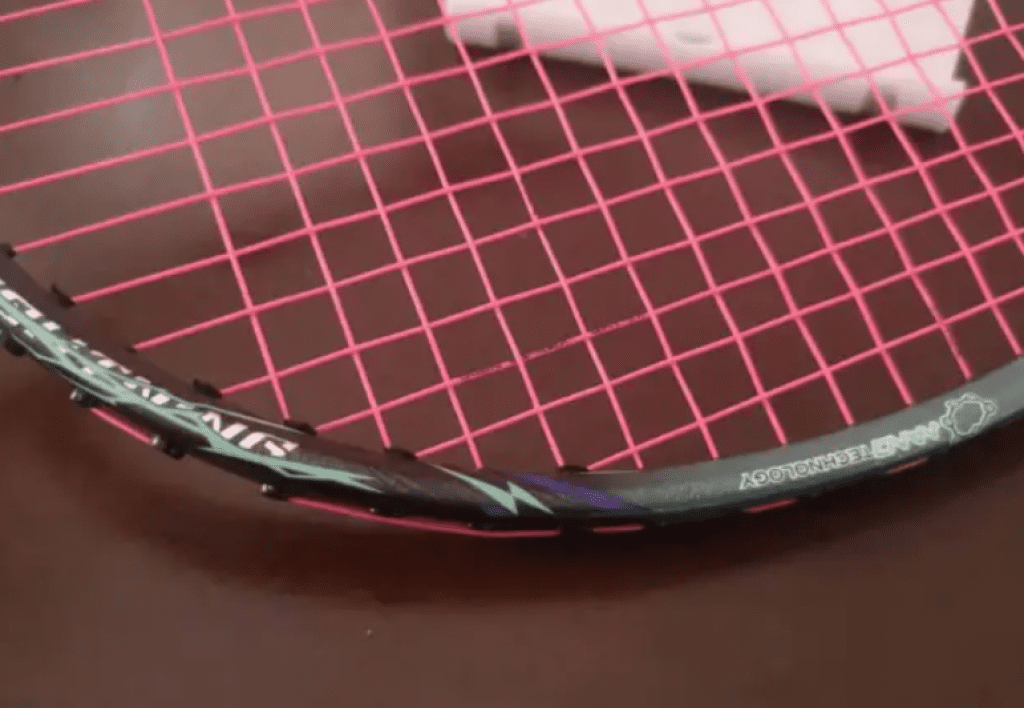
In the recent equipment market, based on my personal experience, it’s still the second-tier brands that are providing the most fun. The Lightning 8900, a model that sold pretty well last year, is sure to have follow-up products from Kawasaki’s associated merchants. But honestly, the first-generation 8900 was already a highly refined model, so if there’s a second generation, where could it improve?
After using it, I was reminded of Zenitsu from Demon Slayer: “Thunder Breathing, First Form: Thunderclap and Flash, Sixfold!”

Specifications: 3U G5, with grip, total weight in use 95.5g, balance point 295mm, 6.8mm shaft, 46T material, length 218mm, medium stiffness, aerodynamic frame, 76-hole string bed, 8-4 point string grooves, warranty up to 30lbs, string tension 24-26lbs vbs66n.
I can’t even count how many products have gone into the “Deep Dark Fantasy” direction after their second generation came out. Although the second generation has two color options and different specifications, they both use black as the base paint, which feels quite natural. The cone cap, as always, features the racket’s specifications and a symbol corresponding to its name. The racket looks slim, and the aerodynamic frame doesn’t have such sharp edges, so it looks more like a diamond-shaped aerodynamic frame that’s been further narrowed. The stickers are not overwhelming, mainly serving as subtle decorations. This time, Kawasaki has shown restraint in areas they excel in, yet the racket remains sharp.

The Lightning II’s frame is also very narrow, which gives it an impressive swing speed. There’s a “whoosh” sound when you exert power, even though it’s a 3U racket—this speed is off the charts. Additionally, the current version’s balance point is set reasonably, without an excessive head-heavy feel. The racket feels well-balanced in hand, which is very friendly for a racket equivalent to a five-star model in Kawasaki’s product grading system.
Although the shaft’s stiffness is moderate, it feels somewhat resilient during play, and the power delivery is very smooth. The C60 fullerene in the shaft always makes me want to exert more force. It’s really easy to drive, giving me no trouble during warm-up clears. The sweet spot is consistent and forgiving, power delivery is comfortable, and the feedback from the shuttle is normal. However, the Lightning II shouldn’t be considered a “syrupy” racket, although I don’t quite know how to explain this contradiction—it doesn’t feel overly indulgent, but it’s very handy to use.

Oh, I really like how the Lightning II performs in fast exchanges. Although the shaft is slightly longer and prone to deformation, the crisp and clean response after hitting the shuttle still allows me to keep up with the pace of the game with this 3U racket. This isn’t just due to continuity and speed, but also the stability brought by the 3U’s own “weight.” Sometimes, even if I can’t react in time, a forehand block can still hold the situation—it’s fantastic.
Not only can the Lightning II maintain a fast pace during exchanges, but it also makes it easier to take the high ground at the net. It performs crisply and cleanly in all aspects, whether it’s pressing, pushing, slicing, or dropping after taking the high ground. At least in this area, I believe this new Kawasaki model is no less than high-end models from major brands and aligns well with its name.

Although the balance point isn’t high, the reduction in shaft diameter has improved the racket’s explosiveness, making the Lightning II’s downward shots even more impressive. I wonder if any players feel the same as I do—Kawasaki shafts have a distinct “Kawasaki feel,” somewhat like elastic rubber. When I first encountered this texture with the Viper, I found it tough to handle, but after adapting, I realized its high energy conversion rate when exerting power. There’s no need to aim for a heavy smash; just maintaining focused downward shots during high-speed movement and rotation throughout the court can yield great results. The key is that the upgraded 6.8mm shaft hasn’t sacrificed the racket’s torsional resistance, allowing for precise or brute-force attacks.

The most comfortable rhythm is the seamless transition between a frontcourt block from your partner and a backcourt smash or drop during high-speed rallies across the court. This is not only a new rhythm capability established in the fast-paced battles supported by the Lightning II but also a result of its clear shock absorption. The quality of its response to downward shots depends entirely on your defensive positioning. If the opponent smashes hard, you can counter to both corners, forcing them into a continuous drain in an amateur match; if the smash is weak, a soft block to the net followed by a net rush can turn the tables; if the smash is off-target, a quick cross-court shot can likely win the point outright.
This new product has just been released, and I’ve been testing it for about a week. If any brand tries to borrow the concept of Demon Slayer in the future, then at least when it comes to Thunder Breathing, my expectations for potential named products will be greatly raised thanks to the existence of the Lightning 8900 II.


Leave a Reply